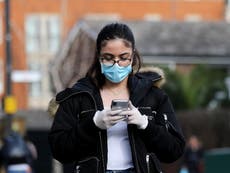Coronavirus: Infections doubling each week in England in ‘concerning’ rise
‘What we are seeing is evidence of an epidemic in the community and not a result of increased testing capacity,’ says professor
Your support helps us to tell the story
From reproductive rights to climate change to Big Tech, The Independent is on the ground when the story is developing. Whether it's investigating the financials of Elon Musk's pro-Trump PAC or producing our latest documentary, 'The A Word', which shines a light on the American women fighting for reproductive rights, we know how important it is to parse out the facts from the messaging.
At such a critical moment in US history, we need reporters on the ground. Your donation allows us to keep sending journalists to speak to both sides of the story.
The Independent is trusted by Americans across the entire political spectrum. And unlike many other quality news outlets, we choose not to lock Americans out of our reporting and analysis with paywalls. We believe quality journalism should be available to everyone, paid for by those who can afford it.
Your support makes all the difference.Coronavirus infections are doubling every seven to eight days in England, according to a major testing programme, amid “worrying signs” of an increase in cases among the elderly.
Researchers at Imperial College London (ICL) said they had found evidence of an epidemic in the community that is “not a result of increased testing capacity” and warned the R rate of transmission could be as high as 1.7.
They sounded the alarm as the UK reported the highest daily number of new coronavirus cases since mid-May: 3,539, up from 2,919 the previous day.
ICL’s Real-time Assessment of Community Transmission (React-1) study – commissioned by the Department of Health and Social Care – said its latest findings, from 22 August to 7 September with 150,000 volunteers, indicated that cases doubled every 7.7 days.
It is estimated that 13 people per 10,000 were infected in England in the same period, compared with four people per 10,000 between 24 July and 11 August – highlighting the growing transmission of the virus.
The study also claims the reproduction rate of the virus now stands at 1.7 based on swab tests among volunteers. An R rate above 1 signifies exponential growth. The study’s figure is separate from the government’s official R rate produced weekly by the Scientific Advisory Group for Emergencies (SAGE).
Professor Paul Elliott, the director of the major programme at Imperial’s School of Public Health, said: “Our large and robust dataset clearly shows a concerning trend in coronavirus infections, where cases are growing quickly across England and are no longer concentrated in key workers.
“What we are seeing is evidence of an epidemic in the community and not a result of increased testing capacity. This is a critical time and it’s vital that the public, our health system and policymakers are aware of the situation as we cannot afford complacency.”
The Department of Health said the report highlighted the need for “vigilance” from the public, adding that cases are on the rise across all adult age groups below 65 and all areas of the country, with the highest rates in Yorkshire and the Humber, the northeast and northwest.
The department added the findings reinforced the need for restrictions unveiled earlier this week that will restrict social gatherings – indoors and outdoors – to six people in the first national curbs on freedoms since the lockdown was eased in England.
Stricter local lockdown measures were also announced for Birmingham and the neighbouring boroughs of Solihull and Sandwell on Friday. From next week, residents are banned from socialising with people outside their own household.
Lockdown measures are also being tightened from midnight on Friday in Lanarkshire due to a rise in cases, the Scottish government said.
Matt Hancock, the health secretary, said: “We’ve seen all across the world how a rise in cases, initially among younger people, leads to hospitalisations and fatalities. The pandemic is not over, and everyone has a role to play to keep the virus at bay and avoid further restrictions.
“It’s so important that everyone abides by the law and socialise in groups up to six, make space between you and those outside your household, get a test and self-isolate if you develop symptoms and wash your hands regularly.
“It is vital you engage with the NHS Test and Trace service if contacted to provide details of your close contacts and self-isolate if you are asked to do so.”
Yvonne Doyle, medical director at Public Health England, said Friday’s increase in infections was “a reminder of the ongoing risk”.
“Most of these cases are people tested in the community,” she added.“Although younger people continue to make up the greatest share of new cases, we're now starting to see worrying signs of infections occurring in the elderly, who are at far higher risk of getting seriously ill.”
A further six deaths were reported on Friday, bringing the total number who have died in the UK within 28 days of a positive test to 41,614.
Separate figures released by the Office for National Statistics showed that the number of new daily infections in private households in England has increased by 60 per cent.
An average of 3,200 positive cases were estimated to have been reported between 30 August and 5 September, the ONS said. This is up from an average of 2,000 people per day between 19 and 25 August.
The ONS estimates that around one in 1,400 people outside of hospitals and care homes had coronavirus in the week up to 5 September.





Join our commenting forum
Join thought-provoking conversations, follow other Independent readers and see their replies
Comments